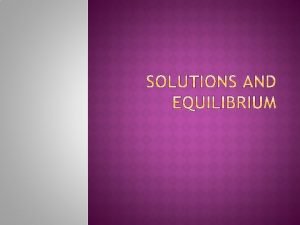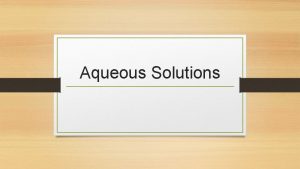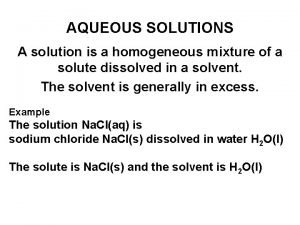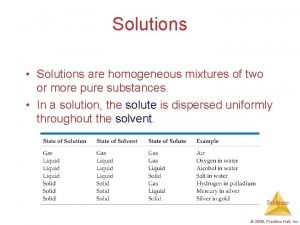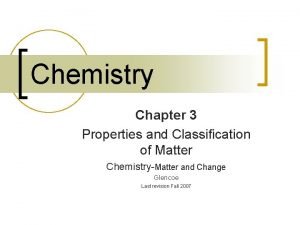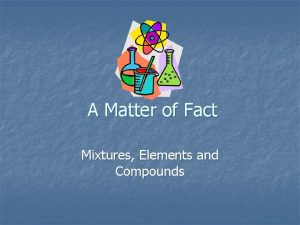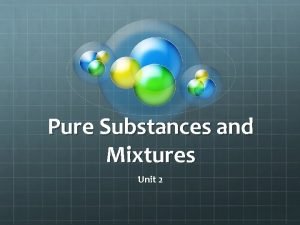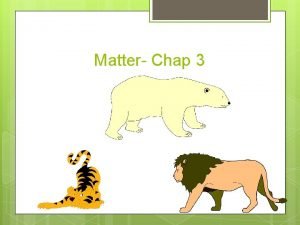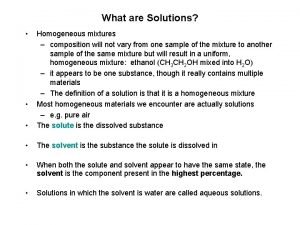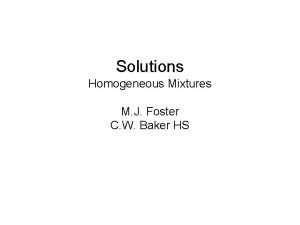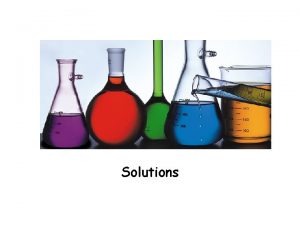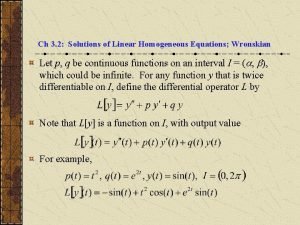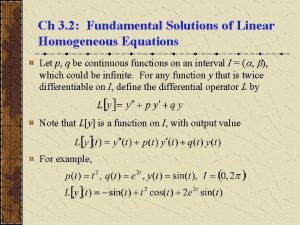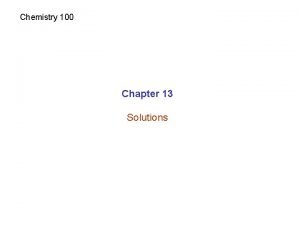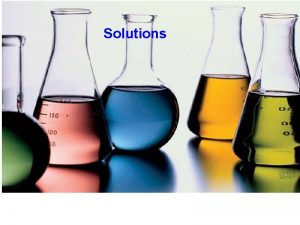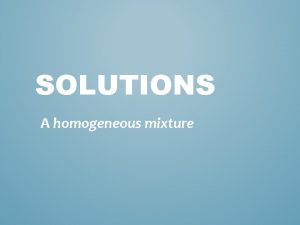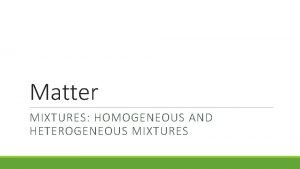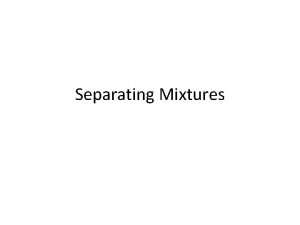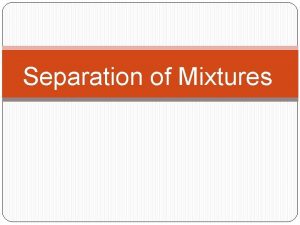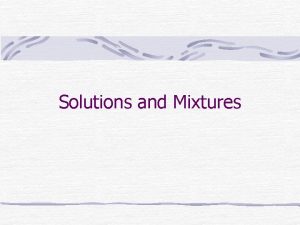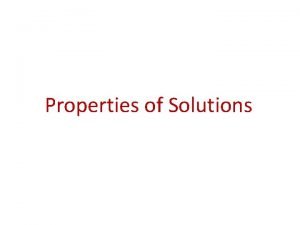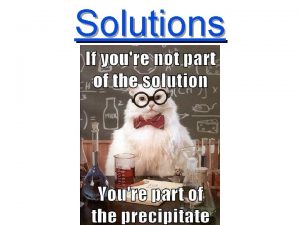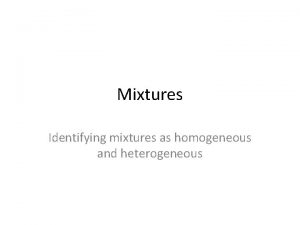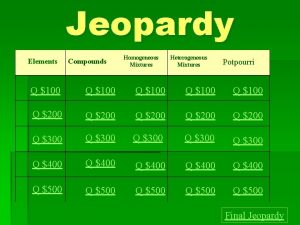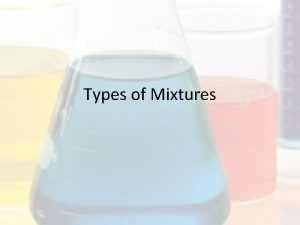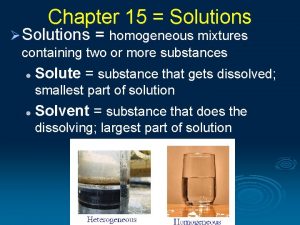Solutions solutions are homogeneous mixtures made up of


















- Slides: 18

Solutions -_____ solutions are _______ homogeneous mixtures made up of two or more ______; substances the ____, solute which _____, dissolves and the ____, solvent which does the ______ dissolving -generally, the ____ solvent is the substance with _____ smaller and numerous particles in the _____, solution while the more _____ solute usually has the _______, larger less _____ numerous particles ____ of the two substances in the _____ solution -_____ solutions can be ______, solids _______, liquids or ______, gases but most often are ____, liquids and ____ liquid _____ solutions are most aqueous since the most common ____ solvent is ______ water often ____, I. Solvation in Aqueous Solutions -_____ solvation is the process of surrounding _______ solute particles with ____ solvent particles to form solution a _____ -solvation done by ______ water is called _____ hydration

Polar Molecules -covalent molecules which are ______ symmetrical in _____ all _______ planes are _____, nonpolar while molecules that are ______ Cl Cl asymmetrical in any plane are ______ polar O N H H Cl Cl Cl -_____ asymmetry in the ______ shape of a molecule is caused by uneven distribution of _____ valence _____, electrons an _______ imbalance of ____ charge in the molecule creating an _____ -molecules containing only _____ nonpolar bonds are nonpolar _____ -molecules containing a ______ symmetrical distribution of ______ polar bonds are _____ nonpolar -molecules containing a ______ asymmetrical distribution of ______ polar bonds are _______ polar O C O O H H H N H H

Polar Molecules -_____ polarity is often created by _____ unshared _______ pairs of ____ valence _____ electrons weak attractions between the molecules -the relatively ________ intermolecular of covalent compounds are called ________, forces the ____ weakest of which are called _____ dispersion or _______ London ____ forces partial ____ poles of ______ polar molecules create -the ____ intermolecular forces called _______dipole stronger __________ dipole ____, forces the most _____ powerful of which are called _____ Hydrogen ______ bonds -_______ intermolecular _______ forces affect the _____ physical ______ properties of _____ covalent _____ compounds like ____ melting ______, point _______ boiling ______, point and _____ solubility

Solutions I. Solvation in Aqueous Solutions -the general rule of _____ solubility is _____ “Like _____ dissolves _____; like” that is, partially ____ charged ______ polar molecules _____ dissolve the fully ionic charged particles of ______ compounds and the partially charged particles of ______ polar _____ covalent compounds

Solutions I. Solvation in Aqueous Solutions A. Factors Affecting -the _____ solvation _____ rate is affected by Solvation Rate three factors which _____ increase the rate of ______ of ____ collision solute and _______ solvent particles -_____, agitation ______ increasing the ____ surface _____ area of the ____, solute and _____ increasing temperature of the ____ solvent all the ______ increase the rate of solvation ____ B. Heat of Solution -if the energy required to overcome the _____ attractive forces between _______ solute and ____ solvent particles is _______ greater than the released during the mixing of energy _____ the particles, _____ solvation is _____, endothermic but _____ solvation is _____ exothermic when more released than _____ required energy is _____

Solutions II. Solubility -_____ solubility is the ____ maximum amount of ______ solute that will ____ dissolve in a given amount of _______ solvent at a specific ______ temperature and _____ pressure -_____ saturated solutions contain the _____ maximum amount of dissolved _______ solute for a given amount of ____ solvent at a given ______ temperature and ____; pressure ______ unsaturated supersaturated solutions contain less than that, and ______ solutions contain more than that

Solutions II. Solubility A. Factors Affecting Solubility -_____ solubility varies according to ______ temperature and _____ pressure -most substances, especially solid substances, dissolved in _______ liquid solvents, have ______ higher solubility at ______ higher temperatures, but ______ gases have lower solubilities at _______ higher ______ temperatures -while ____ pressure has no effect on the solubility of ______ solid or _______ liquid solutes, solubility of ______ gases is ____ directly proportional to ____ pressure ______

Solutions II. Solubility A. Factors Affecting Solubility 1. Henry’s Law -the _____ solubility of a gas ______ varies directly with _____ pressure of the gas above a liquid the ____ S 1 P 2 = S 2 P 1 or S 1 ___ = S 2 P 1 ___ P 2 If the solubility of oxygen gas is 0. 031 L/1 L H 2 O at a pressure of 101 kilopascals, what is the solubility of oxygen, in L/1 L H 2 O, at a pressure of 200 kilopascals? S 1 ___ S 2 = P 1 ___ P 2 0. 031 L/1 L H 2 O ________ S 2 101 k. Pa _______ = 200 k. Pa = 0. 061 L/1 L H 2 O

Solution Concentration I. Percent by Mass What is the percent by mass of a solution containing 20 grams of Sodium Hydrogen carbonate dissolved in 600 grams of water? Percent by mass = = Mass of solute _______ Mass of solution 20 g _____ 620 g x x 100 = 100 3. 2% What mass, in grams, of Sodium hypochlorite is dissolved in 1500. 0 grams of bleach solution that is 3. 62% by mass? Percent by mass 3. 62% Mass of solute = Mass of solute _______ Mass of solution Mass of solute _______ = x 1500. 0 g = 54. 3 g x 100

Solution Concentration II. Percent by Volume What is the percent by volume of Isopropyl alcohol in a solution of rubbing alcohol containing 350 milliliters of Isopropyl alcohol and 150 milliliters of water? Percent by volume = Volume of solute ________ Volume of solution x = 350 m. L ______ 500 m. L 70. 0% x 100 = 100 What volume, in milliliters, of ethyl alcohol is dissolved in a 355 milliliter can of beer that is 5. 0% alcohol by volume? Percent by volume = 5. 0% Volume of solute _______ Volume of solution Volume of solute _______ = x 355 m. L Volume of solute = 18 m. L x 100

Solution Concentration III. Molarity What is the molarity of an aqueous solution containing 40. 0 grams of glucose in 1. 5 liters of solution? Molarity (M) = 40. 0 g C 6 H 12 O 6 Moles of solute ________ Liters of solution 1 mole C 6 H 12 O 6 x ________ 180. 16 g C 6 H 12 O 6 M = = 0. 222 moles _____ 1. 5 L = 0. 15 moles/liter or M 0. 222 moles C 6 H 12 O 6 What mass, in grams, of Hydrogen sulfate must be dissolved in water to make 2. 50 liters of a 1. 0 M solution of Sulfuric acid? Molarity (M) = Moles of solute ________ Liters of solution 98. 077 g H 2 SO 4 2. 5 moles H 2 SO 4 x ________ 1 mole H 2 SO 4 1. 0 mole/L = = Moles of solute ______ 2. 50 L = 250 g H 2 SO 4 or 2. 5 x 102 g H 2 SO 4 2. 5 moles

Solution Concentration IV. Diluting Molar Concentrations What volume, in liters, of a 3. 00 M Potassium iodide solution would you use to make 0. 500 L of a 1. 25 M Potassium iodide solution? M 1 ___ = M 2 V 2 ___ V 1 3. 00 moles/L ______ 1. 25 moles/L V 1 = = 0. 500 L _______ V 1 0. 208 L If you dilute 20. 0 milliliters of a 3. 5 M nitric acid to make 100. 0 milliliters of solution, what is the molarity of the dilute nitric acid solution? M 1 ___ = M 2 V 2 ___ V 1 3. 5 moles/L ______ M 2 = = 100. 0 m. L _______ 20. 0 m. L 0. 70 M

Solution Concentration V. Molality What is the molality of a solution containing 10. 0 grams of Sodium sulfate in 1000. 0 grams of water? Molality (m) = 10. 0 g Na 2 SO 4 Moles of solute ________ Kilograms of solvent 1 mole Na 2 SO 4 x ________ 142. 041 g Na 2 SO 4 m = = 0. 0704 moles _____ 1. 0000 kg = 0. 0704 moles/kg 0. 0704 moles Na 2 SO 4 What mass, in grams, of Naphthalene (C 10 H 8) is dissolved in a 0. 468 m solution containing 500. 0 grams of toluene as the solvent? Molality (m) = 0. 234 mole C 10 H 8 Moles of solute ________ Kilograms of solvent 128. 17 g C 10 H 8 x ________ 1 mole C 10 H 8 0. 468 mole/kg = = 30. 0 g C 10 H 8 Moles of solute ______ 0. 5000 kg = 0. 234 moles

Solution Concentration VI. Mole Fraction What is the mole fraction of Sodium hydroxide in an aqueous solution that contains 22. 8 % Sodium hydroxide by mass? XA 22. 8 g Na. OH 77. 2 g H 2 O n. A ____ n. A + n B = x XB 1 mole Na. OH ______ 39. 997 g Na. OH 1 mole H 2 O x ______ 18. 015 g H 2 O n. B ____ n. A + n B = = 0. 570 moles Na. OH = 4. 29 mole H 2 O XNa. OH = n. Na. OH ______ n. Na. OH + n H 2 O XNa. OH = 0. 570 moles Na. OH ________________ 0. 570 moles Na. OH + 4. 29 moles H 2 O XNa. OH = 0. 117 XH 2 O n. H 2 O = ______ n. Na. OH + n H 2 O XH 2 O = 4. 29 moles H 2 O ________________ 0. 570 moles Na. OH + 4. 29 moles H 2 O XH 2 O = 0. 883

Colligative Properties of Solutions -physical properties of solutions that are affected by the _______, number but not the _____ identity of particles I. Vapor Pressure Lowering -______ vapor _____ pressure is the ____ pressure solvent exerted by the particles of a ____ liquid’s that have escaped the _____ surface and entered into the ____ gaseous state above the liquid -adding ____ solute particles to solution decreases the number of _______ solvent particles at the surface, so _____ increasing solute _______ concentration the ____ decreases the ______ vapor ____, pressure _____ providing the _______ solute particles are ______ non-volatile

Colligative Properties of Solutions II. Boiling Point Elevation -a ____ liquid boils when the ______ vapor atmospheric _____ pressure equals ______, pressure which explains why, at _______ high _____, altitudes where the atmospheric _____ pressure is ______, lower ______ boiling point temperature is ______, lower so to cook food by boiling requires _____ more time -adding ____ solute particles to solution _______ lowers ______ vapor _____ pressure at the same temperature, so the temperature higher vapor must be ______ to raise the _____ pressure enough to equal _____ atmospheric _____ pressure _____

Colligative Properties of Solutions III. Freezing Point Depression -at a solvent’s _____ freezing ______, point kinetic _______ energy of the ____ particles is no longer enough to resist the _____ attraction of the _____ solvent’s ________ intermolecular ____ forces -adding _______ solute to the solvent allows the solution to exist as a ____ liquid at a ______ lower temperature solute particles because the _______ attraction of interfere with the ______________ intermolecular ____, forces which explains why adding _____snow _____ melt ______ salt (____) KCl to snow lowers freezing ______ point temperature, its _____ liquid at allowing it to exist as a ______ lower temperature

Colligative Properties of Solutions III. Freezing Point Depression -so adding _____ ethylene _______, glycol or antifreeze to water in your ______ radiator both ____ lowers the _____ freezing ______ point and _______ raises the ____ boiling ______ point of water IV. Osmotic Pressure -____ osmosis is the movement of ______ water molecules from an area of _______ higher concentration to an area of ______ lower concentration, especially across a semipermeable _____ membrane like a _____ cell _______ membrane solute to a solvent lowers the -adding ____________ concentration of the _______, solvent causing water to move across the _____ membrane towards the ______ lower concentration of water, and the increases the ____ pressure addition of water _____
 Antigentest åre
Antigentest åre Are all solutions homogeneous mixtures
Are all solutions homogeneous mixtures Are aqueous solutions homogeneous mixtures
Are aqueous solutions homogeneous mixtures Are all aqueous solutions homogeneous
Are all aqueous solutions homogeneous Are solutions homogeneous
Are solutions homogeneous Homogeneous differential equation definition
Homogeneous differential equation definition Common homogeneous mixtures
Common homogeneous mixtures Facts about homogeneous mixtures
Facts about homogeneous mixtures Mixture
Mixture What is a heterogeneous mixture
What is a heterogeneous mixture Gas and liquid solution example
Gas and liquid solution example Define homogeneous mixture
Define homogeneous mixture Are solutions homogeneous
Are solutions homogeneous Fundamental solutions of linear homogeneous equations
Fundamental solutions of linear homogeneous equations Fundamental solutions of linear homogeneous equations
Fundamental solutions of linear homogeneous equations Is maple syrup a homogeneous mixture
Is maple syrup a homogeneous mixture Natural science grade 6 term 2
Natural science grade 6 term 2 Chapter 13 solutions chemistry
Chapter 13 solutions chemistry Fossweb mixtures and solutions
Fossweb mixtures and solutions

